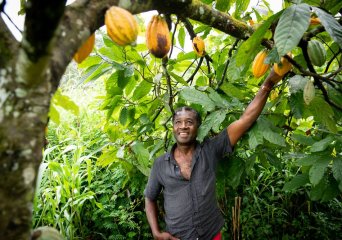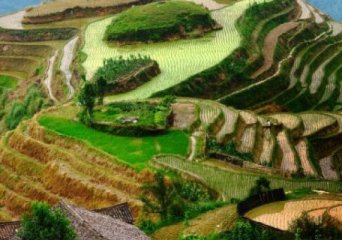Feeding the world
Feeding the world is a challenge. We will have to feed 10 billion people by 2050. More pressingly, we will have to do so within our planet’s limits. This is not impossible, but consumption and production will have to change drastically for it to happen.
This is what feeding the world in 2050 will take
- By 2050, 10 billion people will need access to healthy and nutritious food.
- The food production processes this requires will have to be much more sustainable to minimise climate change and environmental damage. We have to be conscious of our planet’s limits.
- We need to change both our consumption behaviour and our means of food production.
- A larger proportion of our diets should be plant-based products. Food waste must be minimised too.
- Food production should concentrate on other crops. Fewer grains and sugar beet, and more beans, chickpeas, lentils, vegetables and fruit.
- We should also keep fewer pigs and cows for meat production. More pressingly, the production of livestock feed should not interfere with the production of crops for human consumption. We can use waste streams for fodder and graze livestock in less productive areas.
Current trends in food preferences are unsustainable
The world population will grow by more than 40%, from 7 billion in 2010 to 10 billion in 2050. If our food preferences do not change, food production will have to increase enormously by 2050 compared to 2010. This is impossible: we will cross into our planet’s physical limits.
Efficiently feeding the world: from linear to circular food systems
If we want to keep feeding the world and remain within its limits, we will have to find alternatives to our linear food system. We do not have to produce more, but approach food production more intelligently. We have to move to a circular food system.
We can respect natural limits in circular food systems. This means we can ensure that fishing, for example, does not result in a decline in fish stocks. It also means we use as many reusable resources in food production as we can. Soil health and biodiversity should also be dealt with carefully.
The basic principle of food production is to feed the world's population with adequate, healthy and sustainably produced food. This means diets that contain do not contain too much processed red meat, much less sugar and more vegetables.
Preventing waste and producing what we really need
In order to feed 10 billion people by 2050, it is important that we produce and consume differently. We will have to combat food waste and only use the food we truly need. To achieve this, we need to produce food that supports healthy diets.
We also need to handle food waste more efficiently. We can use it as fertiliser or feed for livestock, for example. This will result in less competition between crop production for livestock feed and human consumption.
Example of Europe as a circular food system
The circular food systems project (CiFoS) team at WUR has calculated the impact of implementing a circular food system in Europe. The overall impact of implementing a circular food system in Europe would be a 34% reduction in land use for food production. This would reduce CO2 emissions by 47%. Since less land would be used for food production, Europe’s biodiversity would increase too.
Necessary shifts in consumption behaviours
We will only succeed in feeding the world in 2050 if we adjust how we consume. A modified diet will feature fewer animal products and grains, and more legumes and vegetables. Some meat will have to be replaced by fish. Food waste should be kept to a minimum.
In wealthier, western countries, a relatively large amount of waste occurs through food consumption. In the Netherlands there is a lot to be gained by following simple measures around ‘purchasing, preparing and preserving’.
In poorer parts of the world, there is a lot to gain in terms of food production, storage and distribution. This means that different regions will need to implement different measures to mitigate food waste.
Necessary shifts in production
Food production also needs to be overhauled. Instead of grains, tubers and sugar beet, we should be growing beans, chickpeas, lentils, green and red vegetables and fruit. To achieve a circular food system in Europe, beef and pork production has to be reduced while more fish need to be caught or farmed. Since these interventions mean we will need less land for food production, biodiversity will increase.
Limit competition between livestock fodder and food crops
Too much land is currently being used to produce animal fodder. This land cannot be used to grow crops for immediate consumption. However, using byproducts from food production in a more intelligent way and grazing livestock on land that is unsuitable for direct food production could reduce competition for agricultural land.
Food production could be more efficient
As well as focusing on growing alternative types of crops, it is also possible to make improvements to the crops themselves. By breeding plants, we can increase their food yields and make them more resistant to heat, drought and pathogens. Traditional breeding methods have provided huge yield improvements in the past, while new technologies like genetic modification and gene-editing (CRISPR-Cas) offer opportunities for the future.
Better soil and water management and modern cultivation techniques
A series of measures aimed at improving soil quality and water management in arid areas could also ensure much higher crop yields:
- Fertilisation precisely tailored to the soil’s condition.
- Drip irrigation to reduce water waste.
- Applying insights from organic agriculture to reduce the need for artificial fertilisers and pesticides.
Feeding the world is only possible if we make big changes
If our food preferences and production methods do not change, we will exceed our planet’s limits. By accepting a healthier and more sustainable diet, we can ensure we can keep feeding the world in 2050. By doing so, we can also work to increase biodiversity and mitigate climate change. So with the help of circular food systems, we kill two birds with one stone.
Focus WUR-research

Food Systems
We face the enormous challenge of feeding people around the world in a healthy and sustainable way. With the 'Food System Approach' we are working on healthy and sustainable food systems that are future-proof.

Food security and the value of water
Wageningen University & Research aims to develop new routes toward a sustainable food system. The main challenges achieving this goal are the depletion of freshwater resources, climate change, land management, soil degradation, declining biodiversity, migration the increase in agricultural production and changes in international trade.
Sustainable food production
Food chains
- How to prevent food waste?
- Postharvest quality
- Circular agrofood system
- Food security
- Knowledge and capacities development
Healthy food choices
- Unfortunately, your cookie settings do not allow videos to be displayed. - check your settings
- Unfortunately, your cookie settings do not allow videos to be displayed. - check your settings
Impact stories
Read more of our impact stories
More information
Masters at WUR
Online courses
- Sustainable Food Security: The value of systems thinking
- Sustainable Food Security: Food Access
- Sustainable Food Security: Crop Production
Education for professionals
Project for secondary school
Food security experts
-
drs. TJ (Thom) Achterbosch
Economy and food security -
prof.dr.ir. IJM (Imke) de Boer
Livestock and sustainable food systems -
prof. KE (Ken) Giller
Crop production and nutrients -
prof.dr.ir. MK (Martin) van Ittersum
Sustainable plant production systems -
prof.dr.ir. AEJ (Arjen) Wals
Sustainable development and food security



